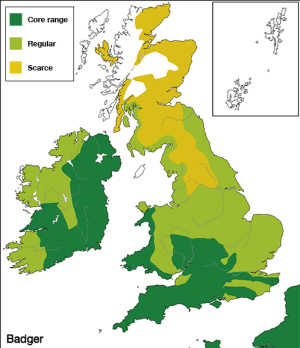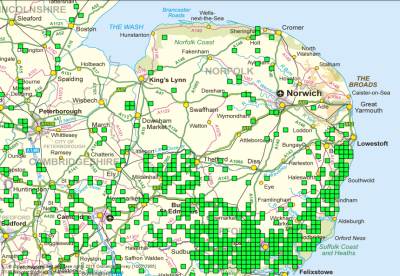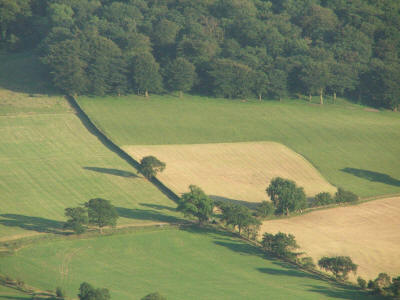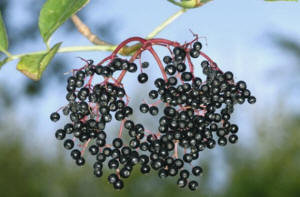Habitat

Geography
Badgers are widespread in Britain but are most common in the south
west, rare in East Anglia and only thinly distributed in Scotland.It is estimated that there are between 40,000 and 50,000 social
groups of badgers in Britain, made up of 250,000 to 400,000 adults which
produce around 170,000 cubs a year. There is considerable variation in
the size of social groups, so these figures can only be estimates.
Claims made by some people that the UK countryside is swarming or
riddled with millions of badgers are utterly false - this has no basis
in fact.
An illustration as to how badgers are distributed across the UK is shown here in the map from the
Mammal Society from 2007).
This shows that badgers are common in the south-west, and regularly
sighted in most of England and much of Scotland. Badgers are scarce in
the high Pennines mountain range; and (at least in 2007) absent from the
Scottish Grampians and most of the Highlands and Islands. Note that this
ia a highly simplified view; as there are parts of the "absent" areas
where badger have been present for generation. It seems likely that
badgers have made modest population increases in many parts of the UK
since 2007.

Badger Distribution Map from the Mammal Society from 2007
An illustration as to how badgers are distributed in very flat areas is shown here in the map from the Norfolk Wildlife Services (part of Norfolk Wildlife Trust).
This shows that there are some areas with high badger densities, but there are others which have few or no badger records.

http://norfolkwildlifeservices.co.uk/badger-distrbn-2015-from-nbn/
Badger mortality is high, with perhaps half of all badgers dying each year. Road traffic accidents
with Motor Vehicles are a major cause of death.
It does not matter how long a badger clan has lived near a busy road,
but they never seem to develop any road sense; and never seem to see
vehicles as a concern until it is too late. The maximum life
expectancy of a badger is about 14 years, though very few survive so
long in the wild.
Habitat
 Deciduous woods, copses and hedgerows are the most usual locations
for setts - especially if this is near open cultivated land. Deciduous woods, copses and hedgerows are the most usual locations
for setts - especially if this is near open cultivated land.
An example of potentially good badger habitat is shown in the photo.
Key parts are the grassland for foraging, the nearby woodland for
shelter and the sloping land for digging a sett into. Periodically
cattle are grazed on these fields; their dung addining to the soil and
encouraging earthworms (these being a vital food resource for badgers).
Elderberry trees are often associated with badger setts and rabbit
warrens, so look for patches of these trees. Elders will grow near
badger setts and rabbit warrens because badgers and rabbit eat
the berries and pass the seeds unharmed through their guts before
depositing them in the droppings nearby. Here the seeds will germinate
and eventually become bushes or trees; thereby repeating the cycle.
 Elder
trees are less than 15 metres in height. The trunk is usually short with
a grey-brown cork-like bark. In the spring the flowers are small and
creamy-white and arranged in a large flat umbrel, up to 30cm across.
After pollination, the flowers turn into small purple-black berries, as
shown in the photo. The twigs of the elder tree are hollow in the
middle, containing a white spongy tissue (pith). Elder
trees are less than 15 metres in height. The trunk is usually short with
a grey-brown cork-like bark. In the spring the flowers are small and
creamy-white and arranged in a large flat umbrel, up to 30cm across.
After pollination, the flowers turn into small purple-black berries, as
shown in the photo. The twigs of the elder tree are hollow in the
middle, containing a white spongy tissue (pith).
A well-established Sett is unmistakable. It will normally have
anything from 3 to 10 entrances, and a few have been found with more
than 50.
These entrances and exits are at least 25 cm wide - much larger
than rabbit holes.
Outside each entrance is a large pile of earth which includes
dried plant material such as grass, hay or straw. This is old bedding which
has been discarded.
You will usually see a latrine close to an entrance too.
Look out for signs near the sett that the badgers have been
foraging: you may see dead leaves disturbed where they have been
rooting.
 A
badger collects bedding material (such as hay, straw and leaves), rolls
it into a bundle and drags it backwards into the sett. A
badger collects bedding material (such as hay, straw and leaves), rolls
it into a bundle and drags it backwards into the sett.



| The Fate of the Badger |
 |
Dr
Richard Meyer objectively examines the evidence on which the
badger-killing programme has been based.Click
here to buy:
Fate of The Badger |
|
